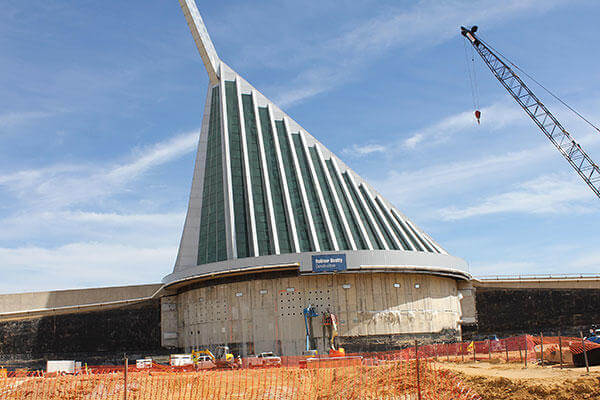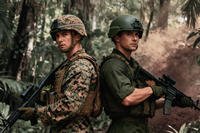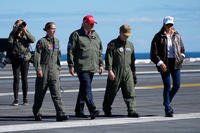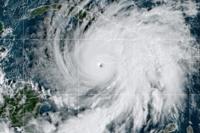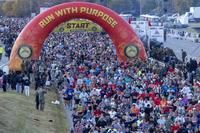MARINE CORPS BASE QUANTICO, Va. — A small, silver lining when mired in traffic on Interstate 95 northbound is catching a glimpse of the massive construction project on-going behind the National Museum of the Marine Corps.
The project is more than an addition. It is the completion of the plan for the museum that was in place even before it opened to the public in 2006.
"This is not an expansion. This is fulfilling our promise to the Marines to have the museum be the go-to place for the history of the Marine Corps," said Lin Ezell, director of the museum.
"After a decade and a half of an extraordinary commitment by so many, the completion of the Museum is inside the horizon," said Lt. Gen. Robert Blackman, President and CEO of the Marine Corps Heritage Foundation. "Thanks to our many donors and their continued support, we will keep working hard so we can honor all Marines from 1775 to the present."
Ezell said the museum chose to open in 2006 with galleries dedicated to conflicts from which there were veterans still living to visit them: World War II through the Vietnam War. In 2010, the museum went back in time and opened "The Early Years," which explores the origins of the Marine Corps in Tun Tavern in 1775 and follows the Corps through its contributions in World War I. These galleries completed the first phase of the building.
"But that leaves a big gap from Beirut to Afghanistan," Ezell said.
That gap is now in the process of being filled. This past spring, workers broke ground on the final phase project, which will add 120,000 square feet to the museum, more than doubling its size. The final phase components include a giant screen movie theater, an expanded education suite, a Marine Sports Hall of Fame, a Marine Corps Combat Art Gallery, a Hall of Valor Gallery, and two galleries depicting Marine Corps history from 1976 to the present day.
The Marine Corps Heritage Foundation led the campaign to raise capital with private funds for construction of the building. The interior renovations, exhibit design, and artifact maintenance are completely funded by the Marine Corps.
Physical construction of the shell of the building will be completed in 2017, Ezell said.
"Our plan is to have an opening each year for four years, from 2017 to 2020," Ezell said. "The goal is to have something awesome to come back to each year."
In 2017, the theater will open with a dedicated film produced by the Marine Corps Heritage Foundation.
Also at that time, the Hall of Valor and Combat Art galleries will open, as will the KidZone children's gallery.
"The children's gallery will take a look at history from the perspective of the little guys and girls," Ezell explained. "It will have stuff to go into and out of. It'll have an emphasis on geography."
In 2018, historical galleries dedicated to conflicts from Beirut to the present day will open. In 2019, the Sports Gallery and Sports Hall of Fame will open, and 2020 will bring the debut of a gallery exploring the interwar years, between World Wars I and II.
Ezell said the construction has been proceeding on schedule and, in some cases, ahead of schedule.
"Our exhibit design team has been working at a good clip," Ezell said. "We are lucky to be able to rely on in-house expertise for that."
Ezell said that designing exhibits focusing on the modern day conflicts is the hardest and most important task the museum will ever take on.
"To impart memories of wars fresh in our minds – this is the hardest thing we'll do," Ezell explained. "Suffering is still raw. There are decided opinions about what's important and those opinions will differ. But it's also the most important thing we'll do, because it honors those in uniform now."
"In no case do we try to glorify war," said Charlie Grow, Deputy Director of the museum. "But we also won't side-step it."
Grow said the designers of these exhibits have approached their jobs with sensitivity. For example, visitors can use a bypass to skip "River Campaign," an immersive space representing a two-story Fallujah or Ramadi-like city which will tell the story of counter-insurgency from 2004 on.
"There is also an exit near the entrance so if people go in and decide it's too much, they can leave right away," Grow said.
Grow added that the museum staff is working closely with the families of Marines whose personal effects are included in the exhibits to ensure that their stories are being told in accordance with the families' wishes. One example of this partnership is with the mother of Cpl. Jennifer Parcell.
Parcell, 20, volunteered for the Lioness program, which used female Marines to search Iraqi women at checkpoints. She was killed in 2007 when a woman she was searching detonated an explosive vest.
The museum has Cpl. Parcell's dress blues and medals.
Grow said that at the current count, there are 575 artifacts going into the new exhibits.
"The footprint of these exhibits is roughly the same size as that of the World War I and II exhibits," Grow said. "Our involvement there was only six years. This is decades long. And the artifacts are bigger than they used to be."
For these reasons, the artifact selection process for the new galleries has been rigorous.
"All the artifacts, even the smaller ones, have to tell multiple stories," Grow explained.
For example, the F/A-18 Hornet attack jet that will be on display has been in inventory since Desert Storm, and it was with a reserve squadron at Joint Base Andrews on September 11, 2001. When the plane hit the Pentagon that day, that Marine Corps Hornet responded.
The M198 howitzer can tell the story of Marine artillery in Desert Shield, but since it came from the 12th Marine Regiment based in Okinawa, it can speak to how Marines are deployed around the world.
A helmet with a bullet lodged in the Kevlar material, belonging to Lt. Col. Ben "Ty" Edwards, can tell the stories of Marines in Afghanistan and teamwork between Marines and Afghan soldiers, battlefield medicine, and the work of spouses at home in caring for wounded warriors.
Lt. Col. Edwards was patrolling a voting registration site in Afghanistan when he heard gunfire. He jumped out of his vehicle to help the Afghan interpreters riding ahead of him and was struck in the head.
"But he's alive, and he's doing OK," Grow said.
Grow said that Lt. Col. Edwards wants his artifact to tell the story of his team, not just himself.
"This is true of 100 percent of the Marines we've talked to for these galleries," said Grow. "They're all humble and deflecting of praise."
